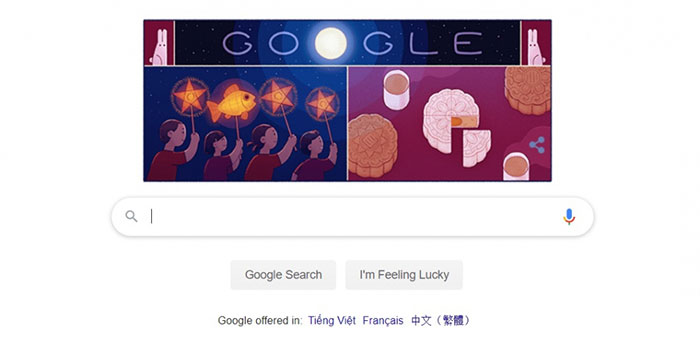Where does the Mid-Autumn Festival come from?
On September 13, Google placed a doodle with the theme of Mid-Autumn Festival. This is a meaningful holiday for children in some East Asian and Southeast Asian countries such as Vietnam, China, Japan, Korea .
The Mid-Autumn Festival has many different names such as Children's Day, Moon Festival or Moon Flower Festival. Mid-Autumn Festival is held on August 15 of the Lunar Calendar. Because this is a "great" occasion for children, it is very near to this day, they will be extremely excited, waiting to go out, buy special items to destroy such as star lights, masks, pull lamps Quan .
Referring to the Mid-Autumn Festival, it is impossible not to mention specialties of baked goods, flexible cakes. Traditionally, the cakes have a mixture of fusion and green bean paste. However, over time, bakers create new flavors like matcha green tea, red beans, black sesame, .
On this New Year, people organize the deck, the moon. The moment the moon rises, children will sing and watch the moon breaking. On the tray, there are many kinds of rice burns, confectionery . Many places organize lion dance, lion dance, dragon dance so that the children can play and play. In China and Chinese neighborhoods around the world there are also fireworks display on this day.

Doodle September 13 changed the theme of the Mid-Autumn Festival.
The history of the Mid-Autumn Festival has not been clearly established, originating from Vietnam's wet rice civilization or receiving from Chinese culture. However, there are three main legends that are best known to talk about the Mid-Autumn Festival: Hang Nga and Hau Nghe, King Tang Minh Hoang to the moon and the legend of Cuoi from Vietnam.
Archaeologists said the image of the Mid-Autumn Festival was printed on the surface of Ngoc Lu bronze drum. Ancient Chinese believe that the Mid-Autumn Festival originated from the Spring-Autumn period. Perhaps the Mid-Autumn Festival began with the wet rice civilization of the South China Delta and the Red River Delta of our country - a harvest festival day when farmers rest and play after a harvest. .
Phan Ke Binh in the Vietnamese book of customs once wrote: " Our people in the 19th century made daytime offering offerings to the ancestors, coming to show off the reward moon. The head of the doll was the moon cake and used various kinds of fruit cake, dyed. colorful, red, white, and yellow. The girls on the street competently skillfully, cut papaya into flowers, mold the dough to make shrimp, whales . " .

On this occasion, Chinese people often organize dragon dances on the occasion of Mid-Autumn Festival, while Vietnamese dances lion or lion dance.
The toys that children play in the Mid-Autumn Festival are paper-backed items such as butterflies, mantis, elephants, horses, unicorns, lions, dragons, deer, shrimps, fish, etc. guide each other to pull, catch the lake drill, procession lights, procession lion, drum, bar la.
Also on this occasion, people buy mooncakes, tea, and wine to make offerings to their ancestors in the evening to welcome the full moon. This is also an opportunity for everyone to express affection to grandparents, parents, teachers, friends by giving moon cakes, fruits, tea or wine.
Chinese people usually organize dragon dances during the Mid-Autumn Festival, while Vietnamese dancers dance lion or lion dance. Lan symbolizes luck, prosperity and auspicious for every home . In the past, Vietnamese people also held Drum Army singing and hanging lanterns during the Mid-Autumn Festival.
In addition to playing for children and adults, the Mid-Autumn Festival is also an opportunity for people to watch the moon to predict the harvest and national destiny. If the autumn moon is yellow, then the year will hit the silkworm season, if the autumn moon is green or green, then that year will have a natural disaster, and if the autumn moon is bright orange, the country will prevail.
- Mid-autumn festival of 8x, 9x childhood is rustic but beautiful and clear
- Customary to welcome the unique Mid-Autumn Festival around the world
- A bunch of nostalgic images of the old Mid-Autumn Festival
- The unforgettable folk games of the Mid-Autumn Festival
- What do Asian countries eat during the Mid-Autumn Festival?
- Mid-Autumn Festival, watching the brightest Jupiter for nearly 50 years
- Know right away: How fat can mooncake be?
- Pumpkin weighs more than a ton to carry by truck
- China warns of 'Mid-autumn' virus
- This moon, what is the strange moon?
- Discover the fall
- Splendid collection throughout the United States
 'Fine laughs' - Scary and painful torture in ancient times
'Fine laughs' - Scary and painful torture in ancient times The sequence of numbers 142857 of the Egyptian pyramids is known as the strangest number in the world - Why?
The sequence of numbers 142857 of the Egyptian pyramids is known as the strangest number in the world - Why? Miracle behind the world's largest stone Buddha statue
Miracle behind the world's largest stone Buddha statue What is alum?
What is alum?